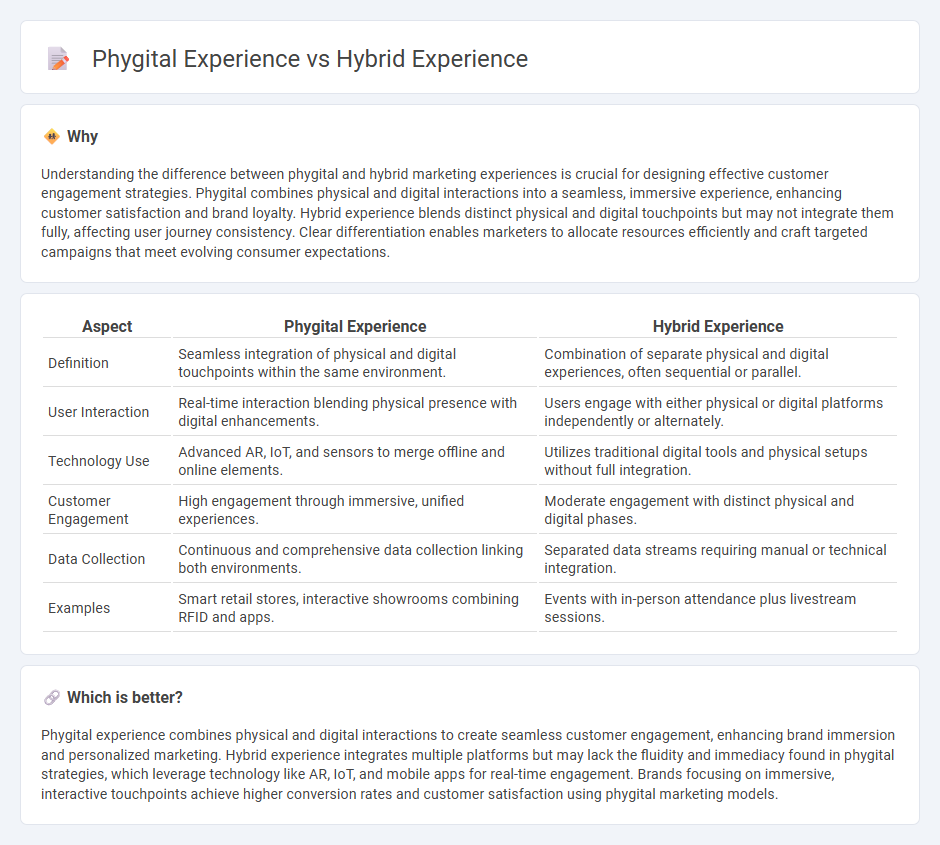
Phygital marketing merges physical and digital touchpoints to create immersive consumer experiences, using technologies like AR, IoT, and interactive displays to enhance in-store engagement. Hybrid marketing combines traditional and digital channels, enabling seamless customer journeys across online and offline platforms, optimizing reach and personalization. Discover how these evolving strategies transform brand interactions and drive customer loyalty.
Why it is important
Understanding the difference between phygital and hybrid marketing experiences is crucial for designing effective customer engagement strategies. Phygital combines physical and digital interactions into a seamless, immersive experience, enhancing customer satisfaction and brand loyalty. Hybrid experience blends distinct physical and digital touchpoints but may not integrate them fully, affecting user journey consistency. Clear differentiation enables marketers to allocate resources efficiently and craft targeted campaigns that meet evolving consumer expectations.
Comparison Table
| Aspect | Phygital Experience | Hybrid Experience |
|---|---|---|
| Definition | Seamless integration of physical and digital touchpoints within the same environment. | Combination of separate physical and digital experiences, often sequential or parallel. |
| User Interaction | Real-time interaction blending physical presence with digital enhancements. | Users engage with either physical or digital platforms independently or alternately. |
| Technology Use | Advanced AR, IoT, and sensors to merge offline and online elements. | Utilizes traditional digital tools and physical setups without full integration. |
| Customer Engagement | High engagement through immersive, unified experiences. | Moderate engagement with distinct physical and digital phases. |
| Data Collection | Continuous and comprehensive data collection linking both environments. | Separated data streams requiring manual or technical integration. |
| Examples | Smart retail stores, interactive showrooms combining RFID and apps. | Events with in-person attendance plus livestream sessions. |
Which is better?
Phygital experience combines physical and digital interactions to create seamless customer engagement, enhancing brand immersion and personalized marketing. Hybrid experience integrates multiple platforms but may lack the fluidity and immediacy found in phygital strategies, which leverage technology like AR, IoT, and mobile apps for real-time engagement. Brands focusing on immersive, interactive touchpoints achieve higher conversion rates and customer satisfaction using phygital marketing models.
Connection
Phygital experience seamlessly combines physical and digital interactions to enhance customer engagement, while hybrid experience integrates online and offline channels to provide cohesive marketing strategies. Both approaches prioritize creating unified brand experiences that leverage technology to bridge gaps between traditional and digital touchpoints. By merging sensory physical elements with digital innovation, marketers can deliver personalized, immersive, and flexible consumer journeys.
Key Terms
Omnichannel
Hybrid experience integrates physical and digital touchpoints, allowing seamless transitions between online and offline channels, enhancing customer convenience and engagement. Phygital experience specifically emphasizes blending physical and digital elements within a single environment to create immersive, interactive experiences that drive deeper brand connection. Explore how omnichannel strategies leverage both hybrid and phygital experiences to deliver consistent, personalized journeys across every customer interaction.
Customer Journey
Hybrid experience integrates digital and physical interactions, allowing customers to switch seamlessly between online platforms and in-store environments during their journey. Phygital experience combines physical presence with digital enhancements within the same interaction point, creating immersive and interactive touchpoints that enrich customer engagement. Explore how these strategies optimize customer journey outcomes and drive satisfaction by learning more about their applications and benefits.
Touchpoints
Hybrid experience combines physical and digital touchpoints to create a seamless user journey, integrating in-person interactions with online platforms for enhanced flexibility. Phygital experience emphasizes immersive, interactive touchpoints within physical spaces augmented by digital technology to enrich customer engagement. Explore how optimizing touchpoints in both models can revolutionize user experiences.
Source and External Links
Hybrid Redefined: Ultimate Guide to the Flexible Workplace - A hybrid experience combines in-person and virtual participation, aiming to create equal engagement and connection for all employees via technology and thoughtful planning, so everyone feels like they're 'in the office' regardless of location.
WHAT IS A HYBRID EXPERIENCE? - A hybrid experience enables both in-person and virtual attendees to participate simultaneously, fostering inclusivity and maintaining corporate culture by bridging the gap between remote and office-based participants.
What is a hybrid event -- Really? - A hybrid event carefully integrates in-person and digital elements tailored uniquely for each audience to optimize engagement and deliver personalized experiences rather than just streaming or bolt-on virtual content to in-person events.
 dowidth.com
dowidth.com